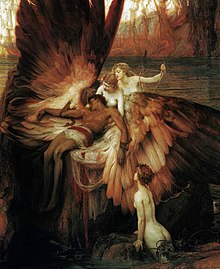In Greek mythology, Icarus (the Latin spelling, conventionally adopted in English;Ancient Greek: Ἴκαρος, Íkaros, Etruscan: Vikare[1]) is the son of the master craftsman Daedalus, the creator of the Labyrinth. Often depicted in art, Icarus and his father attempt to escape from Crete by means of wings that his father constructed from feathers and wax. Icarus's father warns him first of complacency and then of hubris, asking that he fly neither too low nor too high, so the sea's dampness would not clog his wings or the sun's heat melt them. Icarus ignored his father's instructions not to fly too close to the sun, whereupon the wax in his wings melted and he fell into the sea. This tragic theme of failure at the hands ofhubris contains similarities to that of Phaëthon.
Contents
[hide]The Legend[edit]
Oscar Wilde summed up my response to the Icarus myth perfectly:
Never regret thy fall,
O Icarus of the fearless flight
For the greatest tragedy of them all
Is never to feel the burning light.
O Icarus of the fearless flight
For the greatest tragedy of them all
Is never to feel the burning light.
Cast-iron contracts and boardroom acquiescence in excessive rewards are supposedly justified by the need to attract high-fliers with wonderful living standards - and to maintain the latter after Icarus falls to earth.
Many iconic images, the kind long found on posters and greeting cards - Stieglitz's shot of a spindly tree framed by New York office towers on a rainy spring day; Weegee's teeming Coney Island hordes; Lewis Hine's "Icarus Atop Empire State Building" - will be joined by thousands of other works by eminent artists that the general public has rarely had an opportunity to see. There will also be collections of lesser-known photographers like Roman Vishniac, James VanDerZee and Ralph Eugene Meatyard.





沒有留言:
張貼留言